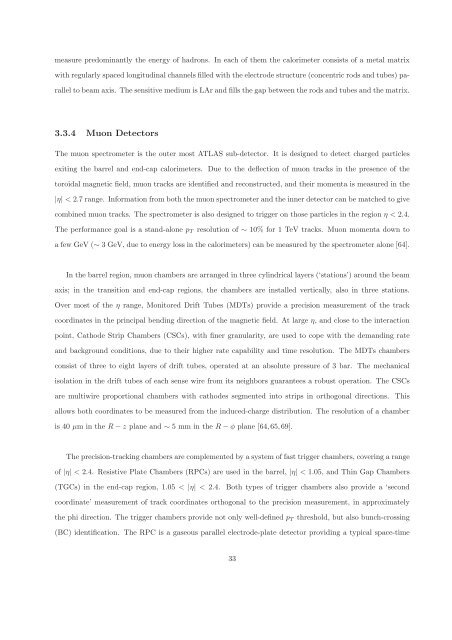CERN-THESIS-2012-153 26/07/2012 - CERN Document Server
CERN-THESIS-2012-153 26/07/2012 - CERN Document Server
CERN-THESIS-2012-153 26/07/2012 - CERN Document Server
Create successful ePaper yourself
Turn your PDF publications into a flip-book with our unique Google optimized e-Paper software.
measure predominantly the energy of hadrons. In each of them the calorimeter consists of a metal matrix<br />
with regularly spaced longitudinal channels filled with the electrode structure (concentric rods and tubes) pa-<br />
rallel to beam axis. The sensitive medium is LAr and fills the gap between the rods and tubes and the matrix.<br />
3.3.4 Muon Detectors<br />
The muon spectrometer is the outer most ATLAS sub-detector. It is designed to detect charged particles<br />
exiting the barrel and end-cap calorimeters. Due to the deflection of muon tracks in the presence of the<br />
toroidal magnetic field, muon tracks are identified and reconstructed, and their momenta is measured in the<br />
|η| < 2.7 range. Information from both the muon spectrometer and the inner detector can be matched to give<br />
combined muon tracks. The spectrometer is also designed to trigger on those particles in the region η < 2.4.<br />
The performance goal is a stand-alone pT resolution of ∼ 10% for 1 TeV tracks. Muon momenta down to<br />
a few GeV (∼ 3 GeV, due to energy loss in the calorimeters) can be measured by the spectrometer alone [64].<br />
In the barrel region, muon chambers are arranged in three cylindrical layers (‘stations’) around the beam<br />
axis; in the transition and end-cap regions, the chambers are installed vertically, also in three stations.<br />
Over most of the η range, Monitored Drift Tubes (MDTs) provide a precision measurement of the track<br />
coordinates in the principal bending direction of the magnetic field. At large η, and close to the interaction<br />
point, Cathode Strip Chambers (CSCs), with finer granularity, are used to cope with the demanding rate<br />
and background conditions, due to their higher rate capability and time resolution. The MDTs chambers<br />
consist of three to eight layers of drift tubes, operated at an absolute pressure of 3 bar. The mechanical<br />
isolation in the drift tubes of each sense wire from its neighbors guarantees a robust operation. The CSCs<br />
are multiwire proportional chambers with cathodes segmented into strips in orthogonal directions. This<br />
allows both coordinates to be measured from the induced-charge distribution. The resolution of a chamber<br />
is 40 µm in the R − z plane and ∼ 5 mm in the R − φ plane [64,65,69].<br />
The precision-tracking chambers are complemented by a system of fast trigger chambers, covering a range<br />
of |η| < 2.4. Resistive Plate Chambers (RPCs) are used in the barrel, |η| < 1.05, and Thin Gap Chambers<br />
(TGCs) in the end-cap region, 1.05 < |η| < 2.4. Both types of trigger chambers also provide a ‘second<br />
coordinate’ measurement of track coordinates orthogonal to the precision measurement, in approximately<br />
the phi direction. The trigger chambers provide not only well-defined pT threshold, but also bunch-crossing<br />
(BC) identification. The RPC is a gaseous parallel electrode-plate detector providing a typical space-time<br />
33















